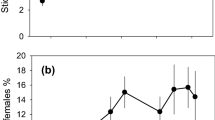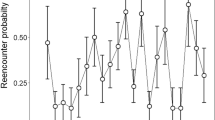Abstract
Gigantism in isolated ponds in the absence of sympatric fish species has previously been observed in nine-spined sticklebacks (Pungitius pungitius). Patterns in sexual size dimorphism suggested that fecundity selection acting on females might be responsible for the phenomenon. However, the growth strategy behind gigantism in pond sticklebacks has not been studied yet. Here, we compared von Bertalanffy growth parameters of four independent nine-spined stickleback populations reared in a common laboratory environment: two coastal marine (typical size) and two pond (giant size) populations. We found that both pond populations had larger estimated final size than marine populations, which in turn exhibited higher intrinsic growth rates than the pond populations. Female growth strategies were more divergent among marine and pond populations than those of males. Asymptotic body size and intrinsic growth rate were strongly negatively correlated. Hence, pond versus marine populations exhibited different growth strategies along a continuum. Our data suggest that quick maturation—even with the cost of being small (low fecundity)—is favoured in marine environments. On the contrary, growth to a giant final size (high fecundity)—even if it entails extended growth period—is favoured in ponds. We suggest that the absence (ponds) versus presence (marine environment) of sympatric predatory fish species, and the consequent change in the importance of intraspecific competition are responsible for the divergence in growth strategies. The sex-dependence of the patterns further emphasizes the role of females in the body size divergence in the species. Possible alternative hypotheses are also discussed.





Similar content being viewed by others
References
Abrams PA, Rowe L (1996) The effects of predation on the age and size of maturity of prey. Evolution 50:1052–1061
Andersson M (1994) Sexual selection. Princeton University Press, Princeton
Arendt JD (1997) Adaptive intrinsic growth rates: an integration accross taxa. Q Rev Biol 72:149–177
Arendt JD, Reznick DN (2005) Evolution of juvenile growth rates in female guppies (Poecilia reticulata): predator regime or resource level? Proc R Soc B 272:333–337
Atchley WR (1984) Ontogeny, timing of development, and genetic variance-covariance structure. Am Nat 123:519–540
Bănărescu PM, Paepke H-J (2001) The freshwater fishes of Europe, vol 5/III. AULA, Wiebelsheim
Barrett RDH, Rogers SM, Schluter D (2008) Natural selection on a major armor gene in three spine stickleback. Science 322:255–257
Bell MA, Ortí G, Walker JA, Koenings JP (1993) Evolution of pelvic reduction in three spine stickleback fish—a test of competing hypotheses. Evolution 47:906–914
Berrigan D, Charnov EL (1994) Reaction norms for age and size at maturity in response to temperature: a puzzle for life historians. Oikos 70:474–478
Biro PA, Abrahams MV, Post JR, Parkinson EA (2004) Predators select against high growth rates and risk-taking behaviour in domestic trout populations. Proc R Soc Lond B 271:2233–2237
Biro PA, Abrahams MV, Post JR, Parkinson EA (2006) Behavioural trade-offs between growth and mortality explain evolution of submaximal growth rates. J Anim Ecol 75:1165–1171
Blanckenhorn WU (2000) The evolution of body size: what keeps organisms small? Q Rev Biol 75:385–407
Blanckenhorn WU, Demont M (2004) Bergmann and converse Bergmann latitudinal clines in arthropods: two ends of a continuum? Integr Comp Biol 44:413–424
Calow P (1982) Homeostasis and fitness. Am Nat 120:416–419
Conover DO, Present TMC (1990) Countergradient variation in growth rate: compensation for length of the growing season among Atlantic silversides from different latitudes. Oecologia 83:316–324
Day T, Rowe L (2002) Developmental thresholds and the evolution of reaction norms for age and size at maturity. Am Nat 159:338–350
Dmitriew CM (2011) The evolution of growth trajectories: what limits growth rate? Biol Rev 86:97–116
Fairbairn DJ (1997) Allometry for sexual size dimorphism: patterns and process in the coevolution of body size in males and females. Ann Rev Ecol Syst 28:659–687
Forsman A (1991) Variation in sexual size dimorphism and maximum body size among adder populations: effects of prey size. J Anim Ecol 60:253–267
Giles N (1983) The possible role of environmental calcium levels during the evolution of phenotypic diversity in Outer-Hebridean populations of the three-spined stickleback, Gasterosteus aculeatus. J Zool 199:535–544
Gonda A, Herczeg G, Merilä J (2009) Habitat-dependent and–independent plastic responses to social environment in the nine-spined stickleback (Pungitius pungitius) brain. Proc Roy Soc B 276:2085–2092
Green BS (2008) Maternal effects in fish populations. Adv Mar Biol 54:1–105
Heino M, Kaitala V (1999) Evolution of resource allocation between growth and reproduction in animals with indeterminate growth. J Evol Biol 12:423–429
Herczeg G, Gonda A, Merilä J (2009a) Evolution of gigantism in nine-spined sticklebacks. Evolution 63:3190–3200
Herczeg G, Gonda A, Merilä J (2009b) The social cost of shoaling covaries with predation risk in nine-spined stickleback (Pungitius pungitius) populations. Anim Behav 77:575–580
Herczeg G, Gonda A, Merilä J (2009c) Predation mediated population divergence in complex behaviour of nine-spined stickleback (Pungitius pungitius). J Evol Biol 22:544–552
Herczeg G, Gonda A, Merilä J (2010a) Rensch’s rule inverted—female-driven gigantism in nine-spined stickleback (Pungitius pungitius). J Anim Ecol 79:581–588
Herczeg G, Turtiainen M, Merilä J (2010b) Morphological divergence of North-European nine-spined sticklebacks (Pungitius pungitius): signatures of parallel evolution. Biol J Linn Soc 101:413–416
Hoogland R, Morris D, Tinbergen N (1957) The spines of sticklebacks (Gasterosteus and Pygosteus) as means of defence against predators (Perca and Esox). Behaviour 10:205–236
Jones JW, Hynes HBN (1950) The age and growth of Gasterosteus aculeatus, Pygosteus pungitius and Spinachia vulgaris as shown by their otoliths. J Anim Ecol 19:59–73
Kahilainen K, Malinen T, Tuomaala A, Lehtonen H (2004) Diel and seasonal habitat and food segregation of three sympatric Coregonus lavaretus forms in a subarctic lake. J Fish Biol 64:418–434
Katsanevakis S (2006) Modelling fish growth: model selection, multi-model inference and model selection uncertainty. Fish Res 81:229–235
Kratochvíl L, Frynta D (2002) Body size, male combat and the evolution of sexual dimorphism in Eublepharid geckos (Squamata: Eublepharidae). Biol J Linn Soc 76:303–314
Kuparinen A, Cano Arias JM, Loehr J, Herczeg G, Gonda A, Merilä J (2011) Fish age at maturation is influenced by temperature independently of growth. Oecologia. doi: 10.1007/s00442-011-1989-x
Lachance S, Magnan P, FitzGerald GJ (1987) Temperature preferences of three sympatric sticklebacks (Gasterosteidae). Can J Zool 65:1573–1576
Laugen AT, Laurila A, Räsänen K, Merilä J (2003) Latitudinal countergradient variation in the common frog (Rana temporaria) development rates—evidence for local adaptation. J Evol Biol 16:996–1005
Lima SL, Dill LM (1990) Behavioural decisions made under the risk of predation- a review and prospectus. Can J Zool 68:619–640
Lindgren B, Laurila A (2005) Proximate causes of adaptive growth rates: growth efficiency variation among latitudinal populations of Rana temporaria. J Evol Biol 18:820–828
Lindgren B, Laurila A (2009) Physiological variation along a geographical gradient: is growth rate correlated with routine metabolic rate in Rana temporaria tadpoles? Biol J Linn Soc 98:217–224
Lomolino MV (1985) Body size of mammals on islands: the island rule re-examined. Am Nat 125:310–316
Marchinko KB, Schluter D (2007) Parallel evolution by correlated response: lateral plate reduction in three spine stickleback. Evolution 61:1084–1090
Moodie GEE (1972a) Predation, natural selection and adaptation in an unusual three spine stickleback. Heredity 28:155–167
Moodie GEE (1972b) Morphology, life history and ecology of an unusual stickleback (Gasterosteus aculeatus) in the Queen Charlotte Islands. Can J Zool 50:721–738
Moodie GEE, Reimchen TE (1976) Phenetic variation and habitat differences in Gasterosteus populations of the Queen Charlotte Islands. Syst Zool 25:49–61
Östlund-Nilsson S, Mayer I, Huntingford FA (2007) Biology of the three-spined stickleback. CRC Press, Boca Raton
Peters RH (1983) The ecological implications of body size. Cambridge University Press, Cambridge
R Development Core Team (2009) R: A language and environment for statistical computing. R Foundation for Statistical Computing, Vienna, Austria. ISBN 3-900051-07-0. URL http://www.R-project.org
Reimchen TE (1983) Structural relationships between spines and lateral plates in threespine stickleback (Gasterosteus aculeatus). Evolution 37:931–946
Reimchen TE (1988) Inefficient predators and prey injuries in a population of giant stickleback. Can J Zool 66:2036–2044
Reimchen TE (1991) Trout foraging failure and the evolution of body size in stickleback. Copeia 1991:1098–1104
Rensch B (1950) Die Abhängigkeit der relativen Sexualdifferenz von der Körpergrösse. Bonn Zool Beitr 1:58–69
Rensch B (1959) Evolution above species level. Columbia University Press, New York
Roff DA (1992) The evolution of life histories. Chapman & Hall, New York
Rohlf FJ (2006) TPS software series. Distributed by the author. Department of ecology and evolution, State University of New York, Stony Brook
Shikano T, Shimada Y, Herczeg G, Merilä J (2010) History versus habitat type: explaining the genetic structure of European nine-spined stickleback (Pungitius pungitius) populations. Mol Ecol 19:1147–1161
Shine R (1989) Ecological causes for the evolution of sexual size dimorphism: a review of the evidence. Q Rev Biol 64:419–461
Sibly R, Calow P (1986) Why breeding earlier is always worthwhile. J Theor Biol 124:311–319
Simberloff D, Dayan T, Jones C, Ogura G (2000) Character displacement and release in the small Indian mongoose, Herpestes javanicus. Ecology 81:2086–2099
Stamps JA, Andrews RM (1992) Estimating asymptotic size using the largest individual per sample. Oecologia 92:503–512
Stearns SC (1992) The evolution of life histories. Oxford University Press, Oxford
Urban MC (2008) Salamander evolution across a latitudinal cline in gape-limited predation risk. Oikos 117:1037–1049
von Bertalanffy L (1938) A quantitative theory of organic growth (inquiries on growth laws II). Human Biol 10:181–213
Waser W, Sahoo TP, Herczeg G, Merilä J, Nikinmaa M (2010) Physiological differentiation among nine-spined stickleback populations: effects of copper exposure. Aquat Toxicol 98:188–195
Werner EE, Gilliam JF (1984) The ontogenetic niche and species interactions in size structured populations. Ann Rev Ecol Syst 15:393–425
Wilson DS (1975) The adequacy of body size as a niche difference. Am Nat 109:769–784
Acknowledgments
We thank Victor Berger, Göran Englund, Tuomas Leinonen, Daniel Lussetti, and Pirkko Siikamäki for their help in organising and executing field sampling. Special thanks to the Oulanka Research Station (University of Oulu) and White Sea Biological Station (Russian Academy of Science) for sharing their facilities and expertise. We are highly indebted to Caitlin Dmitriew and two anonymous reviewers for their comments leading to improvements of our manuscript and Jacquelin DeFaveri for correcting the English. The authors received financial support from the Academy of Finland (GH, AK, JM) and Center of Internal Mobility (CIMO) (AG). The experiments were conducted under the licence of the Finnish National Animal Experiment Board (ELLA, # STH379A).
Author information
Authors and Affiliations
Corresponding author
Rights and permissions
About this article
Cite this article
Herczeg, G., Gonda, A., Kuparinen, A. et al. Contrasting growth strategies of pond versus marine populations of nine-spined stickleback (Pungitius pungitius): a combined effect of predation and competition?. Evol Ecol 26, 109–122 (2012). https://doi.org/10.1007/s10682-011-9491-9
Received:
Accepted:
Published:
Issue Date:
DOI: https://doi.org/10.1007/s10682-011-9491-9




